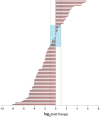Identification of new susceptibility loci for gastric non-cardia adenocarcinoma: pooled results from two Chinese genome-wide association studies
- PMID: 26701879
- PMCID: PMC4963301
- DOI: 10.1136/gutjnl-2015-310612
Identification of new susceptibility loci for gastric non-cardia adenocarcinoma: pooled results from two Chinese genome-wide association studies
Abstract
Objective: Although several genome-wide association studies (GWAS) of non-cardia gastric cancer have been published, more novel association signals could be exploited by combining individual studies together, which will further elucidate the genetic susceptibility of non-cardia gastric cancer.
Design: We conducted a meta-analysis of two published Chinese GWAS studies (2031 non-cardia gastric cancer cases and 4970 cancer-free controls) and followed by genotyping of additional 3564 cases and 4637 controls in two stages.
Results: The overall meta-analysis revealed two new association signals. The first was a novel locus at 5q14.3 and marked by rs7712641 (per-allele OR=0.84, 95% CI 0.80 to 0.88; p=1.21×10-11). This single-nucleotide polymorphism (SNP) marker maps to the intron of the long non-coding RNA, lnc-POLR3G-4 (XLOC_004464), which we observed has lower expression in non-cardia gastric tumour compared with matched normal tissue (Pwilcoxon signed-rank=7.20×10-4). We also identified a new signal at the 1q22 locus, rs80142782 (per-allele OR=0.62; 95% CI 0.56 to 0.69; p=1.71×10-19), which was independent of the previously reported SNP at the same locus, rs4072037 (per-allele OR=0.74; 95% CI 0.69 to 0.79; p=6.28×10-17). Analysis of the new SNP conditioned on the known SNP showed that the new SNP remained genome-wide significant (Pconditional=3.47×10-8). Interestingly, rs80142782 has a minor allele frequency of 0.05 in East Asians but is monomorphic in both European and African populations.
Conclusion: These findings add new evidence for inherited genetic susceptibility to non-cardia gastric cancer and provide further clues to its aetiology in the Han Chinese population.
Keywords: EPIDEMIOLOGY; GASTRIC CANCER; GENETIC POLYMORPHISMS.
Published by the BMJ Publishing Group Limited. For permission to use (where not already granted under a licence) please go to http://www.bmj.com/company/products-services/rights-and-licensing/.
Conflict of interest statement
Figures


References
-
- Ferlay Jea. GLOBOCAN 2012 v1.0, Cancer incidence and Mortality Worldwide: IARC CancerBase No. 11. International Agency for Research on Cancer, 2013.
Publication types
MeSH terms
Substances
Grants and funding
LinkOut - more resources
Full Text Sources
Other Literature Sources
Medical
